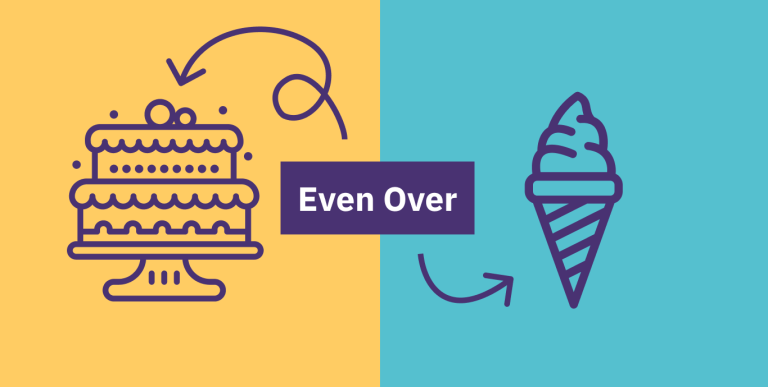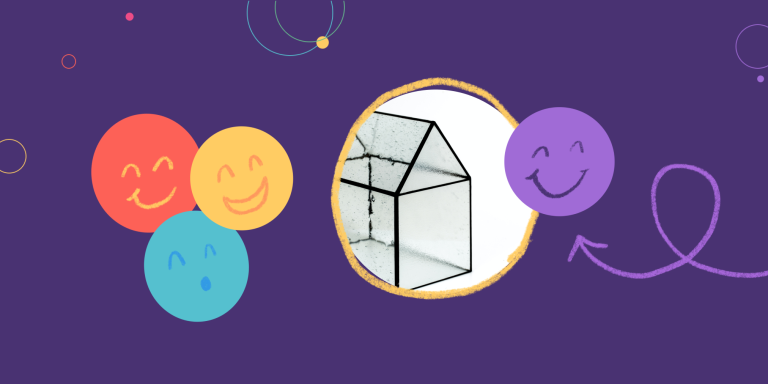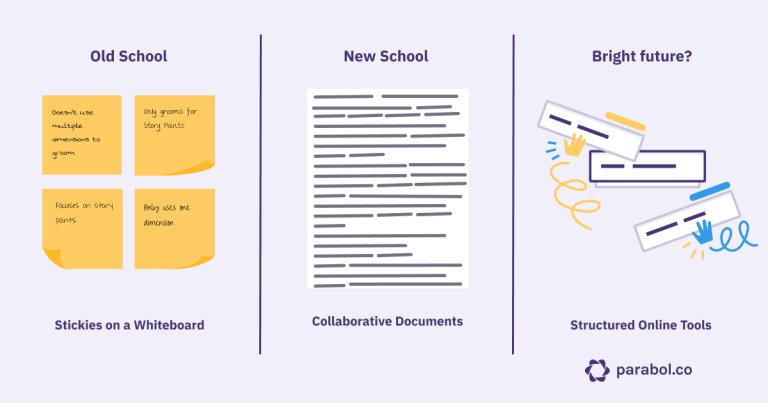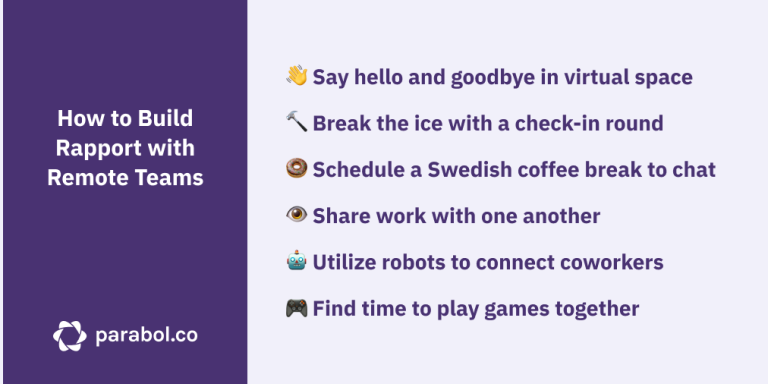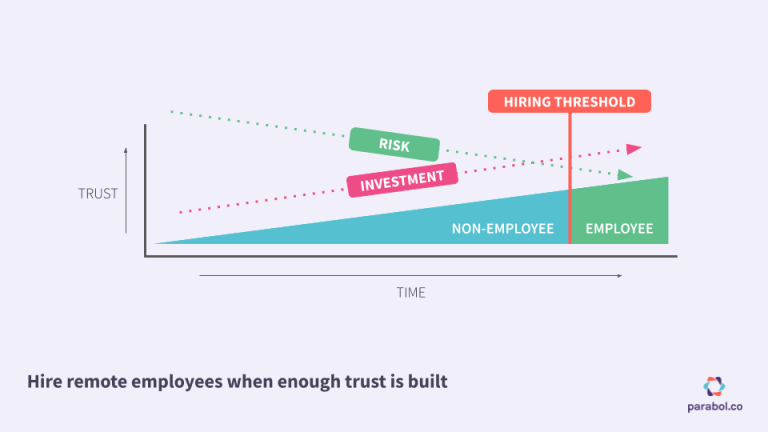What We Learned From a Year of Virtual Retreats

In the before times, our team used to meet up in-person at least three times a year.
While we’re a fully-distributed team, we’ve always known that there’s a special magic that happens when you see someone in person and share physical space with them. It’s hard to describe exactly what is different or why it matters, but it’s something you know in your gut that does matter.
So, a few times a year, we would pause, leave our homes, and fly somewhere to gather in person.

And then the pandemic hit.
We ran our first fully virtual retreat in July 2020, and since then, we’ve run a few more. In some ways, we’ve learned how to make them better than in-person activities! But nothing replaces being able to smile at each other over a dinner table, waiting to break bread together.
Here’s what we’ve learned on our remote retreat journey. Hopefully there are some tips and tricks here you can steal for your own virtual get-togethers.
The transition from in-person to virtual
Let’s first talk about what remote retreats (or SPAs in Parabol language) are:
- A quarterly retreat to talk about strategy and vision, not just a vacation for the entire team
- An opportunity to bond and do some team-building through memorable experiences, not a boring corporate retreat in a conference room
Great remote retreats happen when teams can strike a balance between meaningful work and memorable experiences.
With in-person retreats, time zones collapse and our team can all join together synchronously.
But with virtual retreats, we’re still at the mercy of time-zones, which gives us limited sync time each day for those memorable experiences and meaningful work to take place.
There are three main changes we’ve had to contend with:
- Growing, remotely! Since our last in-person company retreat, our team has grown from 5 employees (two of whom were very new!) to 11 employees. So we’re also adjusting to running retreats with a larger group.
- ⌚Finding sync time. As our team has grown, it has also gone from being entirely in California and Texas to spread all over the world. That makes finding a convenient time to meet more challenging.
- Working cross-functionally. Remote retreats are a chance for us to work cross-functionally in ways we can’t otherwise. Most of our team hasn’t met in person, so our virtual retreats are particularly precious as a chance to ‘meet’ and work with one another in a different way.
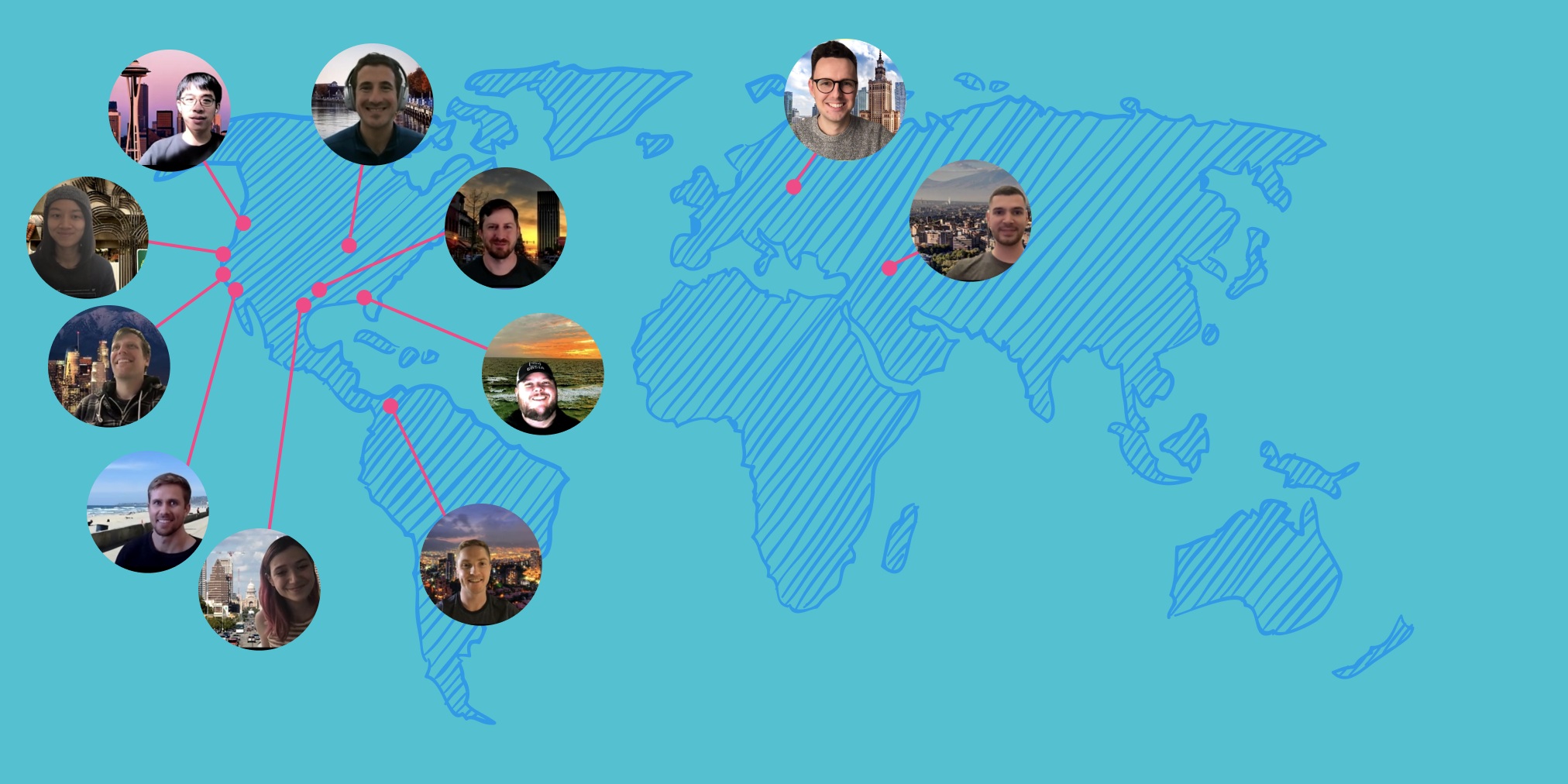
We shared plans early to set context for the retreat
Structure is important to our remote team. That love of structure flows from how our product works all the way through to how we organize remote retreats.
For a multi-day retreat, we don’t have a standard, repeatable format. Instead, we set a team retreat agenda beforehand to guide us through the right steps.
Here’s an example of our remote retreat schedule: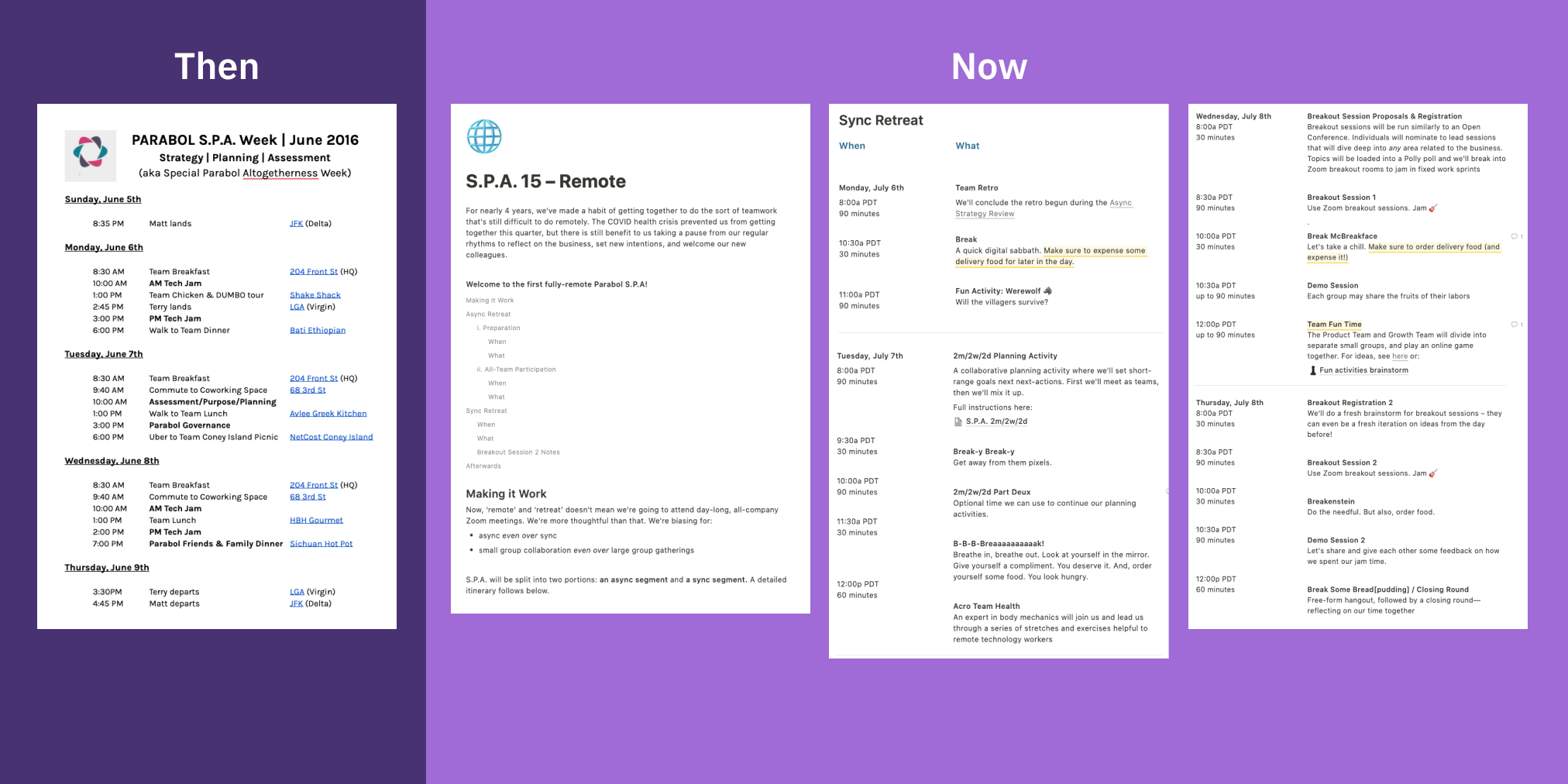
Setting an agenda lets the whole team know what to expect, and prepare for it.
While we can adjust our daily schedules based on our needs each day, a retreat typically requires more of us to be on the same schedule. Individual team members can’t change a meeting time on the fly, because it impacts so many others.
Sharing the remote retreat agenda beforehand gives team members the time and space to adjust the timing of personal commitments and plan ahead so they’re not stretched or inconvenienced.
We keep everything in a Notion doc, including:
- ⏰ The time for each activity
- Time zone details
- ⏳ How long the activity will last
And we make sure to include plenty of imaginatively titled breaks. 
Sharing the agenda openly lets anyone check when things are scheduled, and takes the burden off of any one person to manage timings.
We optimized our schedule for video calls and different time zones
Much has been written about Zoom fatigue and how video conferencing is strangely more tiring than in-person meetings.
Team retreats often end up being boxed into two days and packed with a lot of content. Our own in-person retreats used to work in a similar way, with two days of deep work, jam-packed with content.
But when shifting to virtual retreats, the idea of two full days on Zoom sounded… exhausting.
Remote retreats are the heartbeat of Parabol. They offer a chance to take stock, plan ahead, be creative and also have a breather and connect before the next quarter of work. We don’t want people to go away from this experience exhausted.
That’s why we limited the amount of Zoom time during remote retreats to 4 hours per day and included plenty of breaks.
This sync time on Zoom is more expensive in terms of energy than meeting in-person. So we adjusted by having less hours per day spread over more days.
To ensure we could still have deep conversations and the opportunity for multiple cycles, we spread the work over four days, giving ourselves one day off at the start of the week. Since we’d have a travel day for an in-person retreat, a day-off to clear our heads seemed like the right trade off. 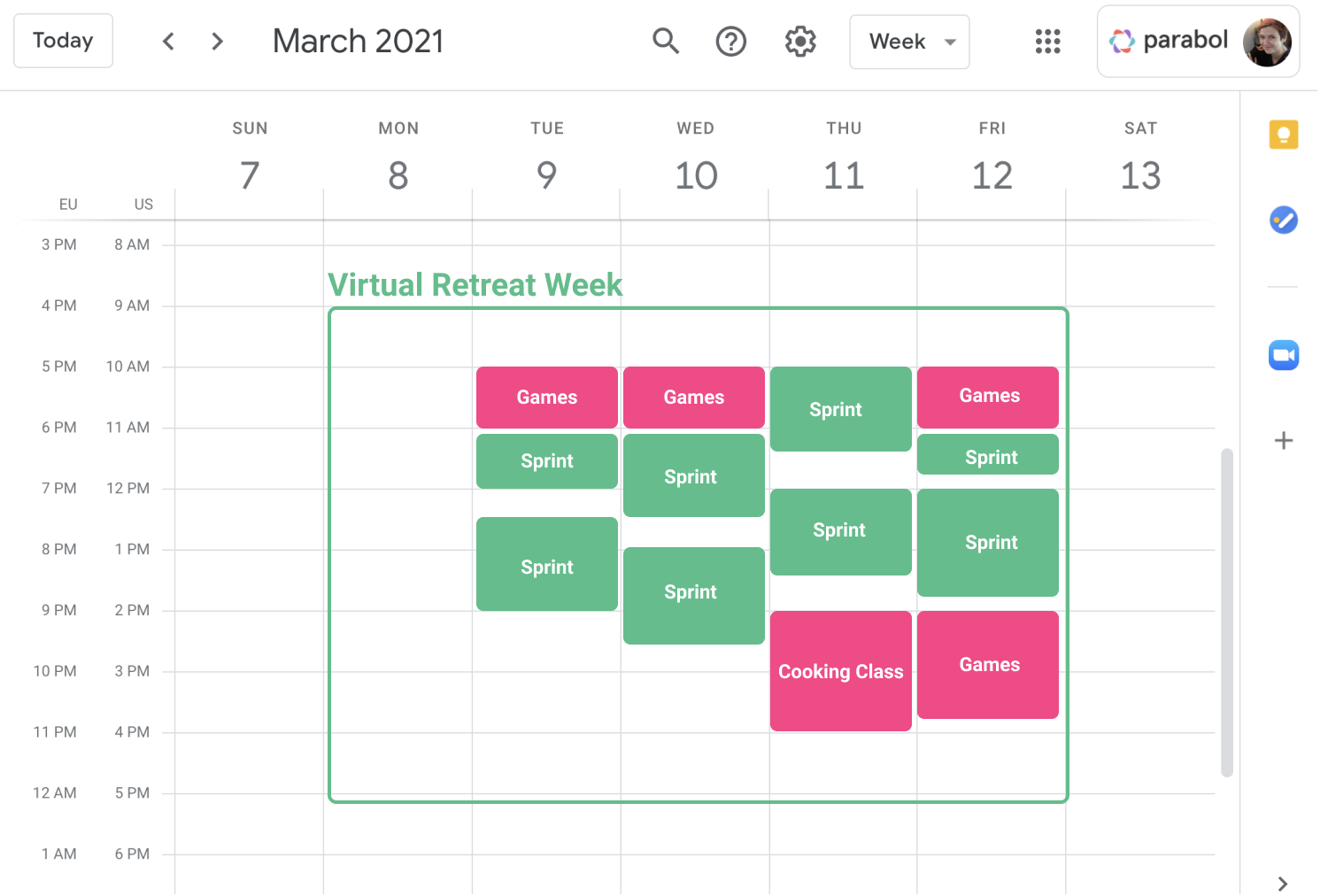
We also made sure to schedule our remote retreat in the hours that give us the most convenient overlap across time zones, and explicitly told team members to adjust their schedules as they prefer to make that time work.
For coworkers in Europe, that meant working evenings for a week. For those on the West Coast of the US, that meant starting their day a bit early.
We prioritized interaction over consumption
A traditional ‘all hands’ or ‘retreat’-style experience often ends up being an endless stream of presentations. The management or executive team shares their thoughts and findings, while most of the team sits in the audience, consuming the content and thinking about what’s for lunch.
For our in-person retreats, we’ve made an effort to avoid this. The presentation format just doesn’t work well when you’re 3-5 people gathered around a table. Staring at a laptop with slides doesn’t feel like the best use of anyone’s in-person time.
For our virtual retreats, we wanted to avoid sliding (see what I did there?) into passive consumption and keep things interactive instead.
To that end, we brought in some tried-and-true habits:
- Crowdsourcing what we work on. To decide what we’ll work on for the week, we use our own retrospective meeting tool to crowdsource ideas about what folks would like to tackle. All ideas are submitted anonymously so everyone’s voice is heard and counted equally. We identify topics or issues we’re feeling excited about, and vote on what to take on. We even use the Discussion Threads feature to decide who will work on what. This means everyone participates in deciding what we’re working on, rather than being handed projects from above.
- Creating artifacts. Instead of spending time presenting, we use the majority of our sync time to jam on the projects we’ve selected and create an artifact we can demo to the team. Like in a hackathon or hack week, the focus of sync time in our retreats is always ideating, building, and creating.
- Questions and reactions. When there is a chance to demo our work, everyone has a chance to offer clarifying questions and reactions, similar to our async decision making practice. This gives everyone a chance to speak, making the experience more interactive.
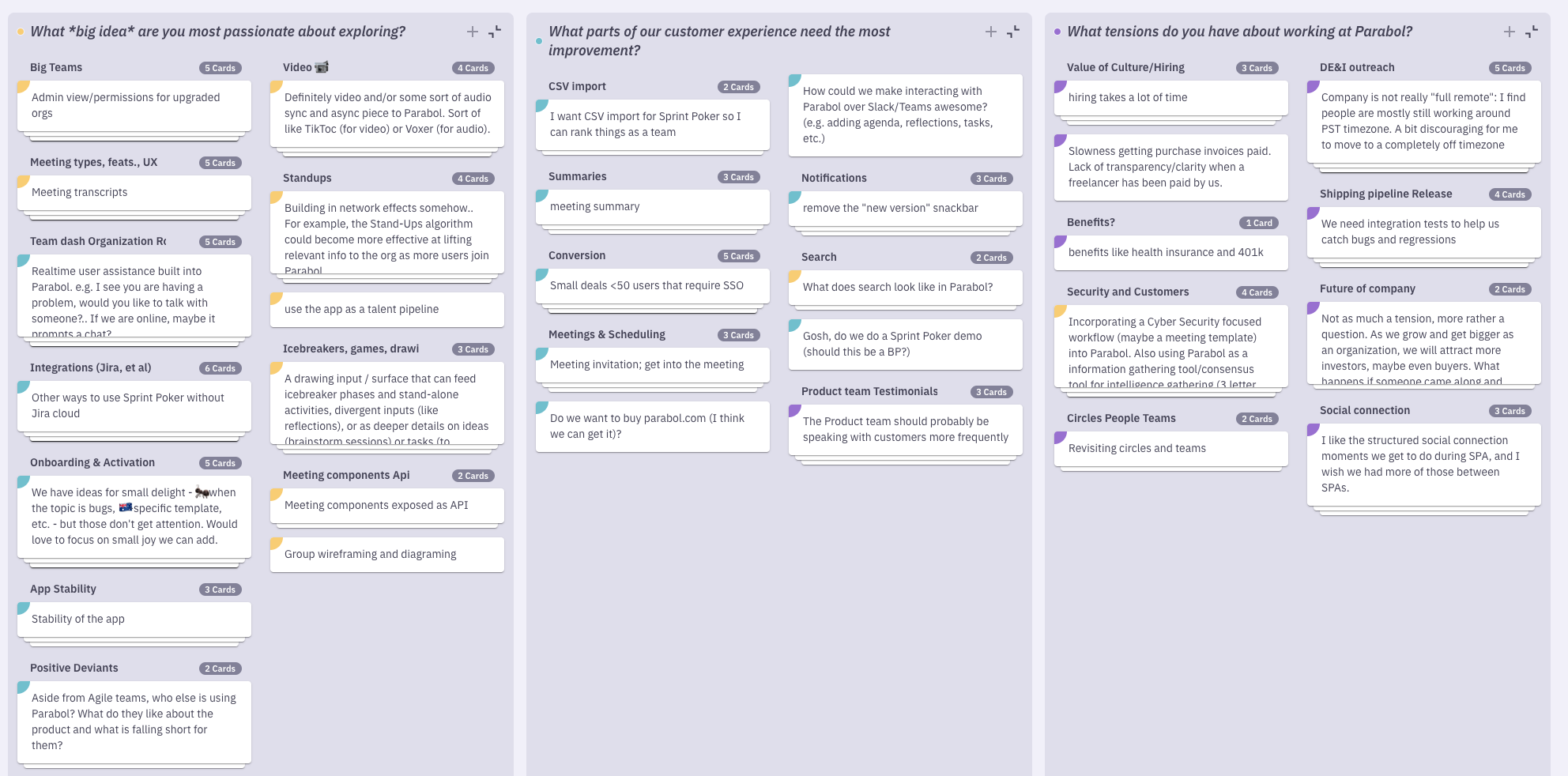 These practices take a traditional top-down retreat experience and turn it on its head. This makes our remote retreats more interactive and democratic, in line with our team culture.
These practices take a traditional top-down retreat experience and turn it on its head. This makes our remote retreats more interactive and democratic, in line with our team culture.
We moved deep strategy work to an async process
We have a loose rule at Parabol that if it can be a video, it doesn’t need to be a meeting. In our regular work, we lean heavily on Loom to give quick, visual updates to one another. We may talk through a metrics dashboard, give a demo of a new feature or design, or just share how we accomplished a new thing we tried.
One of the things we do at each remote retreat is approve a strategy for the coming quarter.
In previous retreats when we met in person, this used to take one whole day. Because company strategy is a big thing, and some folks like to think slowly about big things, we wanted to try making it async. Frankly, we also didn’t want to take eight hours or two days Zoom meetings to get through it.
Here are the steps we take to set our async company strategy::
- CEO pair-works strategy document with others on the leadership team
- CEO shares a Loom video and Google Doc on the proposed strategy with team for feedback
- Team asks clarifying questions, gives reactions on a thread in Slack
- CEO runs through a consent-based decision-making process for the team to agree to the strategy
This gives us the opportunity to review deep thoughts over time, without cramming an important decision into a big portion of your virtual retreat. If we find there are big objections or concerns, we have the option to use a sync conversation to discuss those concerns specifically.
We regularly run retrospectives on our remote retreats so we can improve the process. The team loved the async strategy-setting process:
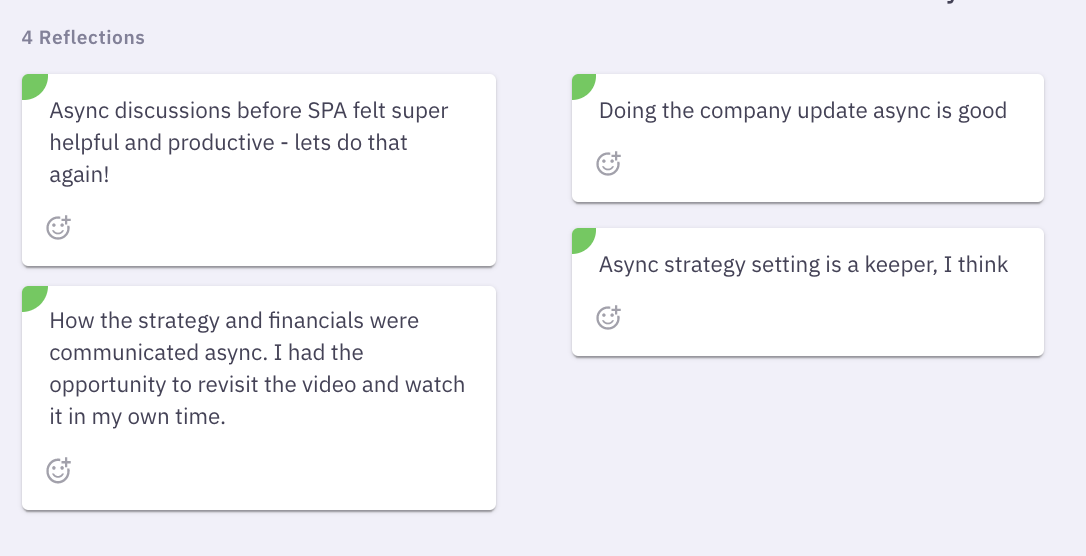
As a bonus, we also realized that this option gives us an artifact – a Loom video – that explains our strategy in detail, along with the reasoning behind it. This can be shared with candidates and new hires after our remote retreat, to help them understand what we’re thinking in as much detail as other employees.
We bridged the physical and digital to create novel experiences
One of my favorite experiences of the one in-person SPA that I attended was getting tacos with the team. It felt quintessentially LA – a large “truck” had taken over this alleyway, and they were making great tacos and selling agua fresca. It was novel, distinct, and memorable.

We obviously can’t ship these tacos to everyone, but we can take our learnings and bring what made this experience great to our remote retreats.
We know that:
- Food connects people
- New experiences stand out in our memory
With that in mind, we scheduled a xiaolongbao cooking class for our most recent retreat. We got to experience the vulnerability of struggling to make the appropriate jelly for the dumplings, the joy of creating something new (and eating it), and the peace of mind in realizing that no matter how you fold the dumplings, they’ll still be tasty.

This cooking class is already folding into the narrative of our company. We have inside jokes about our jelly-making abilities, to start. By investing in unique activities like this, we can bond even over great distances.
We’ve also tried other kinds of activities. In our first remote SPA, we played online games, but in future ones, we wanted to focus on activities that couldn’t fit into our regular #fika calls – things that took more time to do or more setup and effort.
At our October retreat, we shipped every Parabol team member a GPS tracker, took 2 days off, and encouraged everyone to go geocaching. As team members communed with nature in their various locations, we shared videos and photos about our experience, creating a feeling of being in it together despite being apart.
We’ve also tried playing Lego together. We gave the team prompts ahead of time, and got together to share our creations. 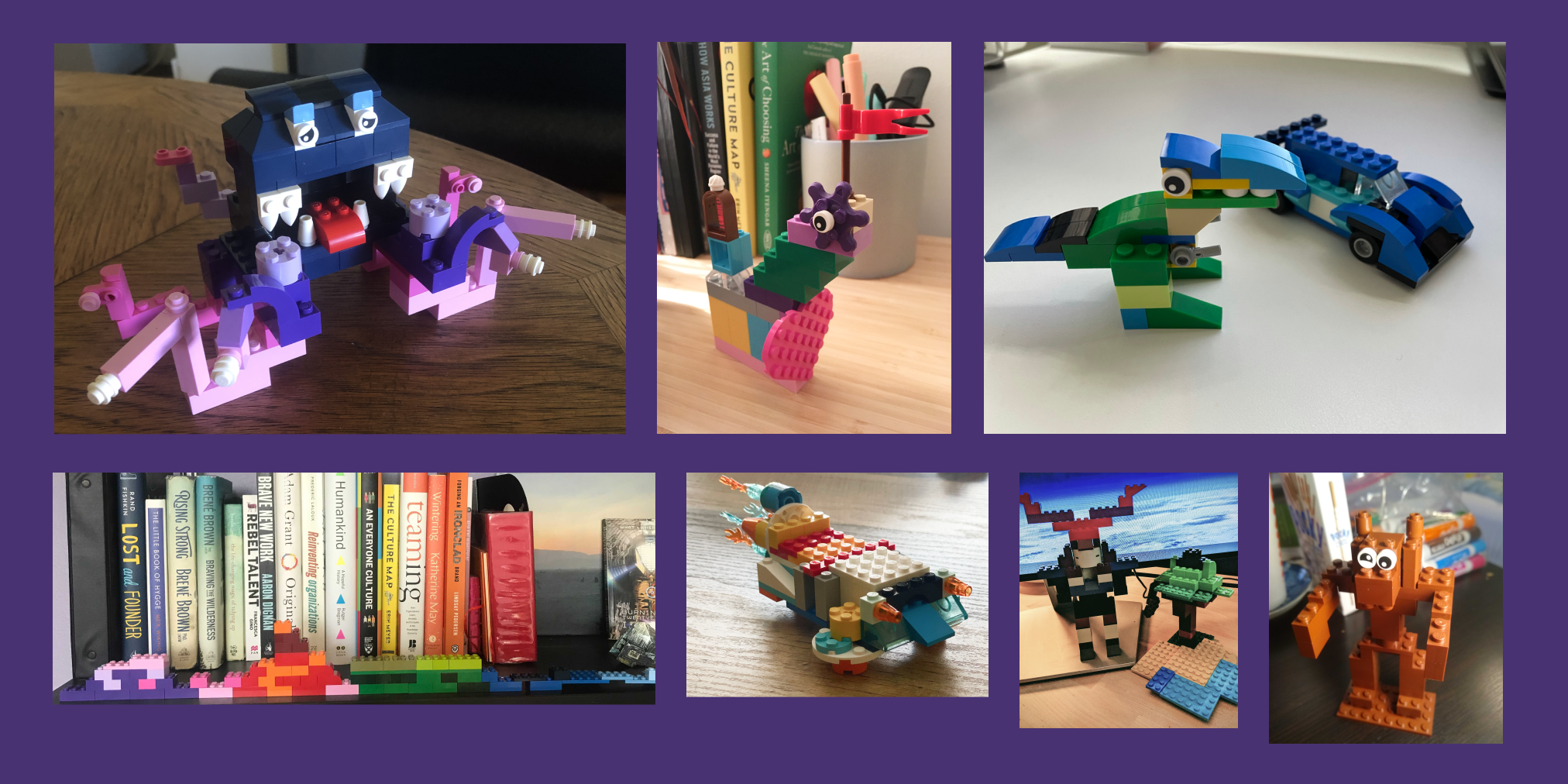 Activities that require interacting with the physical environment – like cooking, geocaching, or Lego – help us break out of the surreal nature of virtual work. For one, they allow us to interact with something other than screens, which can be really grounding. For another, you’ll see one another in a more 3D sense, which helps us understand one another better as real humans.
Activities that require interacting with the physical environment – like cooking, geocaching, or Lego – help us break out of the surreal nature of virtual work. For one, they allow us to interact with something other than screens, which can be really grounding. For another, you’ll see one another in a more 3D sense, which helps us understand one another better as real humans.
For our Lego and geocaching activities, because we shipped the needed tools to everyone, team members each received a mysterious and exciting package to open. Besides the fact that it’s nice to get a gift in general, team mates also started to get excited about our remote retreat and shared their joy with one another.
We took a ‘less is more’ approach to our work
For our in-person SPAs, we’d have several 2-hour blocks where a subset of the team joined together to sprint on an idea. Afterwards, they’d share their findings, and then we’d move on to another sprint, on another topic.
At our first virtual retreat, we followed this same format, and it felt… unsatisfying. This came out in our retro after the retreat: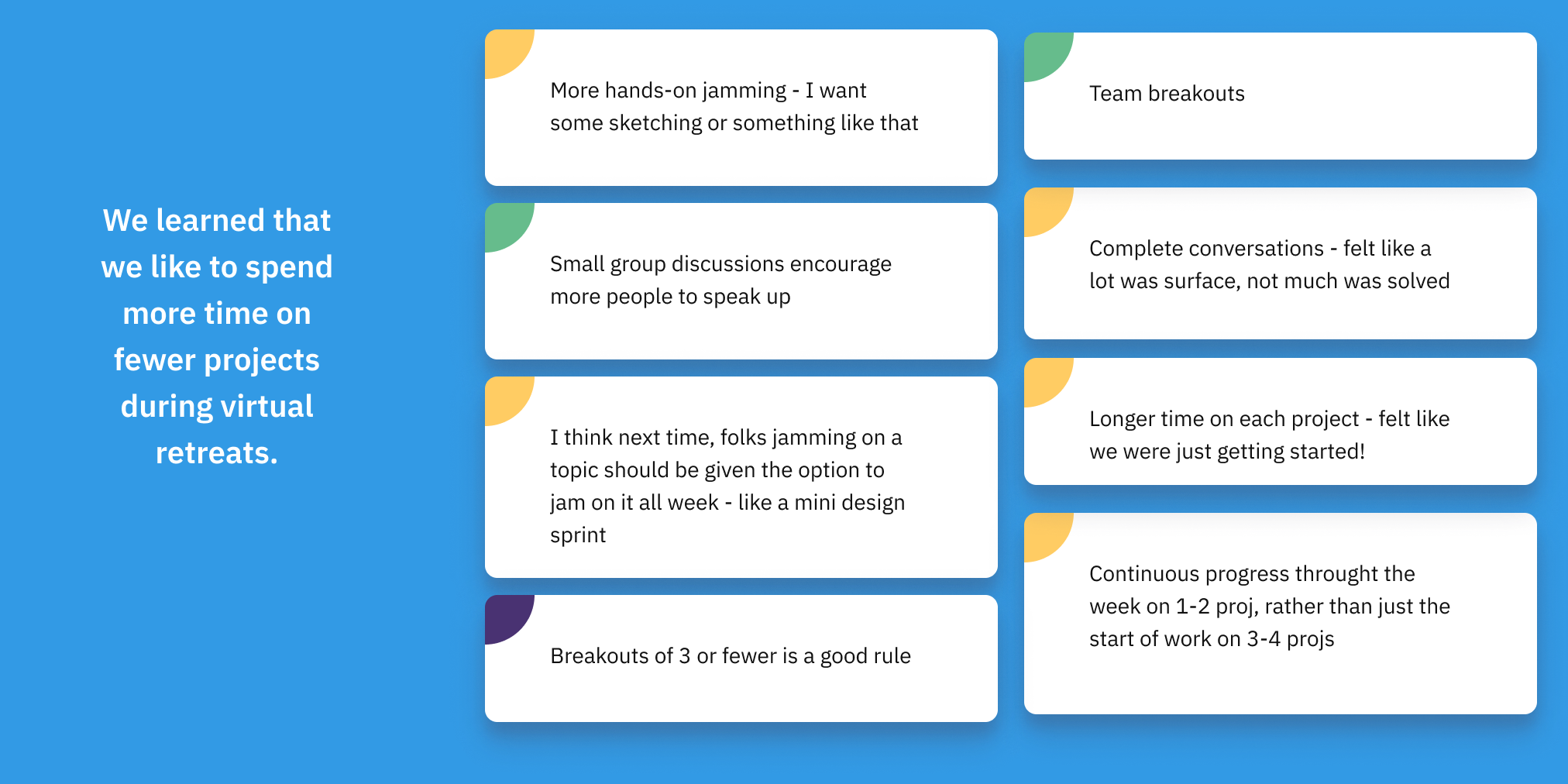
In person, there’s a lot of pinging back-and-forth that can happen when you’re sharing a space. Remotely, the same energy isn’t quite there. It can be harder to go through the same number of cycles.
To account for this, we decided that our collaborative teams should stay on one topic for the whole retreat, with a demo in the middle to bring in the rest of the company. 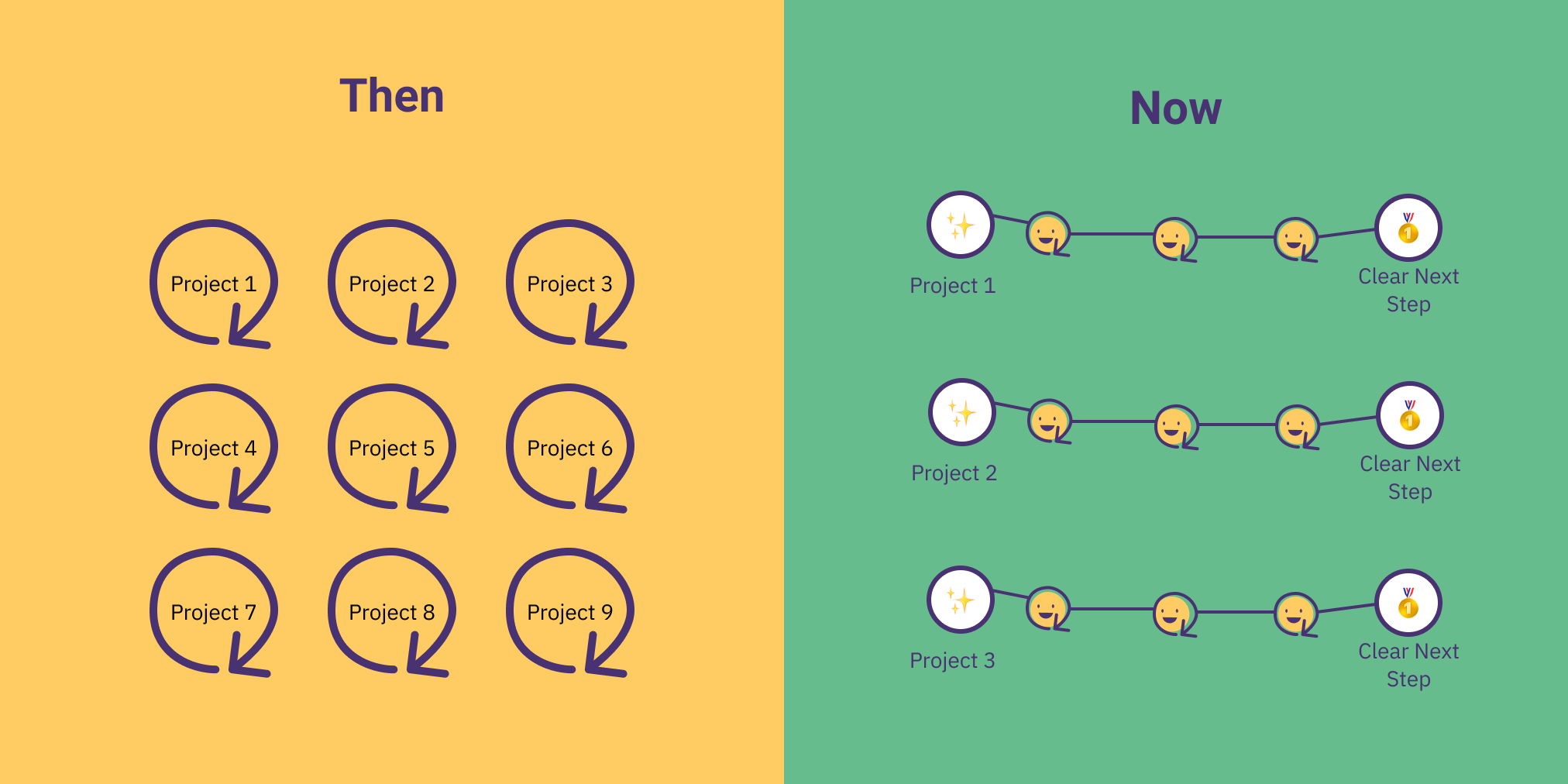 Doing multiple sprints on each topic allows us to get deeper and iterate. While we don’t cover as many topics, we get deeper with each one.
Doing multiple sprints on each topic allows us to get deeper and iterate. While we don’t cover as many topics, we get deeper with each one.
We prioritized time in small groups even over whole company time
One of the things that SPA stands for is “Special Parabol All-togetherness,” and the time we spend together really is special. Remote retreats offer a unique opportunity to spend time with folks outside of our normal teams and workgroups, to think of ourselves as ‘Parabol’ and not ‘the product team’ or ‘the growth team’.
Working in small groups has become more, not less, important as our headcount grows. Discussions with 10+ people in a video call are not fun and often not productive, whether they’re decision-making conversations or team-building activities.
Moreover, it’s hard to to know people and build rapport in these larger groups. As our company grows, we need to keep an eye on maintaining the depth of our relationships, even as there are more of us.
With a co-located meetup, we could organically gather on one side or the room or the other, and have smaller side conversations. Subsets of the group could find commonality or shared interests, naturally breaking up into smaller groups.
Over Zoom, it’s not so easy.
So we’ve focused more and more of our schedule on small-group interactions over whole-group interactions.
In practice, that looks like:
- Cross-functional teams of 3-4 people max to tackle the projects we pick in our initial crowdsourcing and shortlisting
- Game tournaments, rather than having everyone playing at once
- Playing games or a team building activity in breakout groups
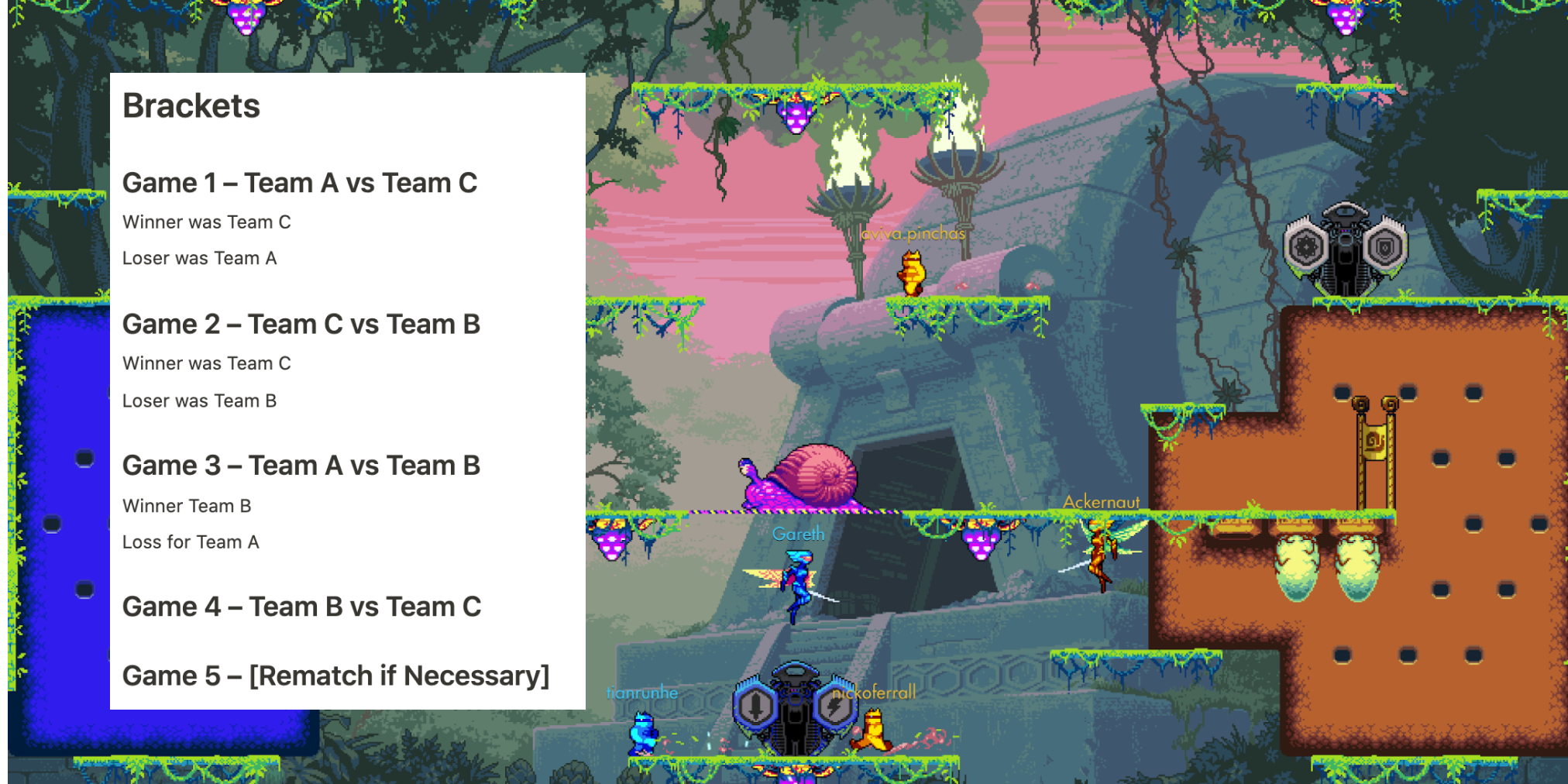
Here are a few of the icebreakers and games we have used in our remote retreats.
By limiting groups to 3-4 people, but varying the groups, each person gets a richer interaction with their teammates overall. Other teams running remote retreats offer similar advice.
Right now, the leader of an activity assigns the breakout groups or decides the tournament. As we grow to a larger size, we might consider a tool like Mozilla Hubs or Gather Town so people can organically mill about to the activity of their choice.
We took pictures because they last longer
For a co-located retreat, teams naturally take photos to document that interesting view, that tasty food, or that weird way your coworker put their laptop on the chair.
Sometimes, during a virtual retreat, something similarly memorable may happen, like this peak work-from-home moment: 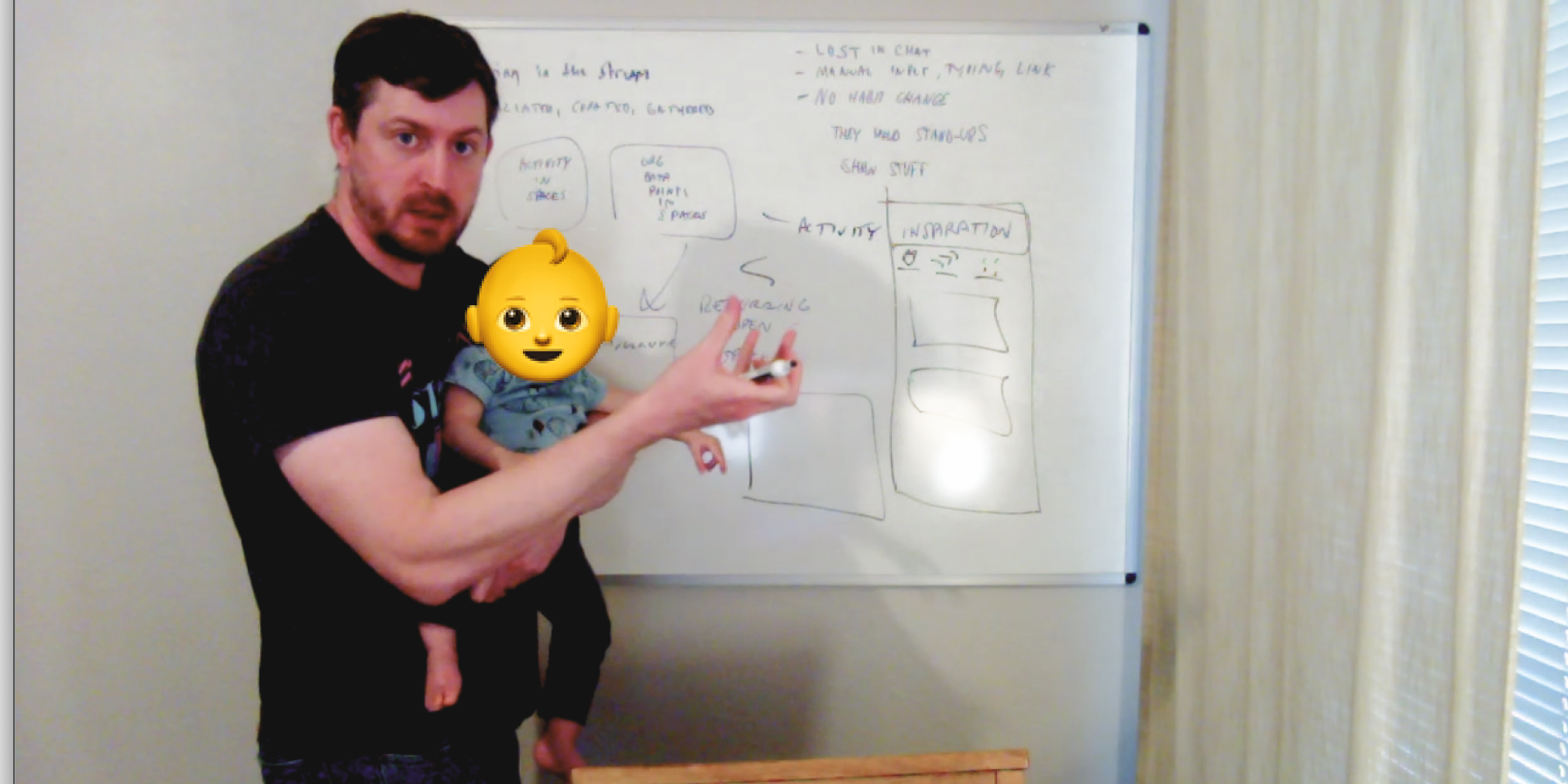
But oftentimes, the experiences are fleeting, and so are the memories. Unique experiences do inspire folks to take photos, but they might document the activity, but not the team. For example, I took a picture of my soup dumpling (above), but not who I made it with.
Just like the team at Microverse, we decided to add in time for some creative team photos at our retreat, and we got some gems.  These memories and artifacts form the fabric of your narrative as a company. They’re a little piece of our collective memory.
These memories and artifacts form the fabric of your narrative as a company. They’re a little piece of our collective memory.
As we navigate a year-long pandemic, marking time and acknowledging that it’s passing is increasingly important for our mental health and happiness. The size of our team and the faces of the folks on it is one reminder that things are changing.
We don’t know how tall anyone is – and we want to
The year has let us re-imagine how retreats can work, and stretched the boundaries of remote collaboration. We were happy with our original version of a virtual team retreat, but we’re even more pleased with how we’ve evolved our practice.  All that said… we really want to meet in person! It feels like there’s a point where we’ve got to know each other as far as we possibly can online. We want to take our working relationships to the next level.
All that said… we really want to meet in person! It feels like there’s a point where we’ve got to know each other as far as we possibly can online. We want to take our working relationships to the next level.
And we can’t wait to find out how tall everyone is.






